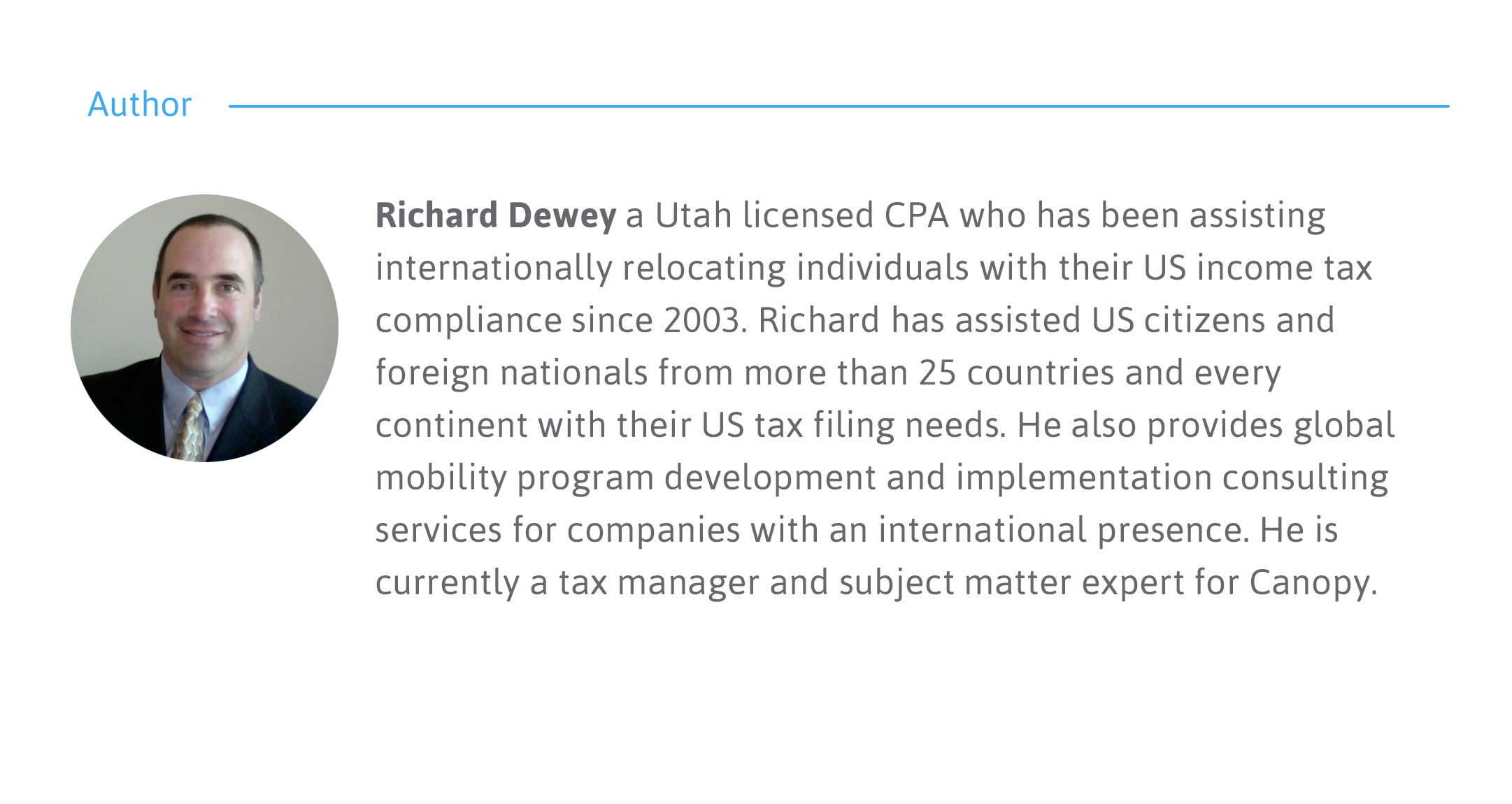In an earlier blog post, our team gave some insight into the growing number of US expatriates and an overview of services they may need from tax professionals. In this post, we’ll take a deeper dive into some tax preparation strategies for US expatriates.
As you know, the risk to expatriates is that their income can be subject to double taxation (i.e. in both the country where they work and in the US). The overall goal is to minimize total worldwide income tax. If your strategy is sound, the expatriate’s worldwide income tax liability will be less than or equal to their tax liability in one country.
There are two main tools used for minimizing US taxes for expatriates: the Foreign Tax Credit (FTC) and the Foreign Earned Income Exclusion (FEIE). Most often you’ll only need to use one of these tools, but in some situations you’ll want to use the two together. In this post we’ll take a look at sourcing income and the different situations for using the FTC and FEIE.
Sourcing Income
Before discussing the FTC and FEIE, I want to briefly discuss the concept of sourcing income to the correct country. Only foreign taxes related to foreign source income are eligible to generate foreign tax credits. Only income that is sourced to a foreign country can be excluded through the Foreign Earned Income Exclusion. Sourcing rules can be very complex and vary based on the type of income. For example, wage income will be proportionally sourced to different countries based on work days in each country. Fringe benefits, like housing, will be sourced to the country where the benefit is received.
Fringe benefits, like housing, will be sourced to the country where the benefit is received.
Using the Foreign Tax Credit
Using only the Foreign Tax Credit is a strategy to consider when your client is working in a country with higher tax rates than the US. The FTC can be a very appealing option because every dollar of this credit offsets a dollar of US income tax. There are essentially two limits on the amount of foreign tax credit a person can claim:
- The amount of foreign taxes actually paid or accrued
- The amount of US taxes that would have been due on the same foreign source income
The limit will be whichever amount is less of the two.
For example, if your client is working in a low tax country such as Singapore (assuming the US individual works all year in Singapore and all income is Singapore source) their situation may look like this:
$300,000 taxed at 20% (estimated tax rate) = $60,000 of Singapore tax
$300,000 taxed at 30% (estimated tax rate) = $90,300 of US tax
$90,300 - $60,000 = $30,300 US tax still due
Note that in this example the total worldwide income tax due is equal to the client’s highest tax rate even though in this case, the client had to pay taxes to two different countries.
Using only the Foreign Tax Credit is a strategy to consider when your client is working in a country with higher tax rates than the US.
Using the Foreign Earned Income Exclusion
Using only the FEIE is a strategy to consider when the client’s total wage income is less than the annual exclusion limit because 100% of the income would be excluded and no US income tax would be due. The limit of income you can exclude using the FEIE is $102,100 for 2017. The amount is periodically adjusted for inflation.
One thing to consider is that to qualify for the FEIE, your client has to establish tax residency outside of the US. The FEIE won’t be an option for short-term work assignments. There are two tests that can qualify someone for the FEIE:
- Physical Presence Test: If your client spends 330 days of a 365-day period outside of the US
- Bona Fide Residence Test: If your client is a bona fide resident of a foreign country for an uninterrupted period that includes an entire tax year
Keep in mind, any foreign taxes paid that are tied to income that has been excluded through the FEIE are not eligible to be used as foreign tax credits. Also, in the year your client moves, they will likely not be outside the US for an entire year and will be proportionally limited on the amount of FEIE they can used based on time outside the US.
Using only the FEIE is a strategy to consider when the client’s total wage income is less than the annual exclusion limit because 100% of the income would be excluded and no US income tax would be due.
Using Both Tools Together
You may want to use both the FTC and the FEIE together if your client has a high income and lives in a low tax country such as Singapore. For example, if your client makes $300,000 a year, using only the Foreign Tax Credit would result in offsetting the US tax liability by the lower amount of taxes paid in Singapore. They would have a net balance due to the US. Consider the previous example:
$300,000 taxed at 20% (estimated tax rate) = $60,000 of Singapore tax
$300,000 taxed in 30% (estimated tax rate) = $90,300 of US tax
$90,300 - $60,000 = $30,300 US tax still due
In contrast, by using the FEIE first, $102,100 can be fully excluded from taxation in the US and the Foreign Tax Credit can be applied to the amount still due. Consider the following example:
$300,000 - $102,100 (FEIE limit) = $197,900 taxable income
$197,900 taxed at 20% = $39,580 of Singapore tax allowed as FTC
$197,900 taxed in the US = $63,500 of US tax before FTC
$63,500 - $39,580 = $23,920 US tax due after FTC
In this example, using both the FTC and FEIE would lower worldwide taxes from $90,300 to $83,920 ($60,000 in Singapore tax + $23,920 in US tax), saving your client $6,380.
As I mentioned earlier, the Singapore tax paid on the excluded $102,100 cannot be used as a Foreign Tax Credit. However, the Singapore tax paid on the remaining $197,900 can be.
You may want to use both the FTC and the FEIE together if your client has a high income and lives in a low tax country.
Planning Long Term
Long term planning is key because some tax decisions have long-term consequences. For example, if your client revokes the FEIE (by not claiming it on their tax return) while working in a high tax country such as in the UK, that revocation will last for 5 years. Revoking the FEIE while working in the UK may sound like a good idea, but if your client transfers to a low tax country after the first year of working in the UK, they cannot start using the FEIE without receiving special permission from the IRS.
As much as possible you and your client should consider the long-term ramifications of their tax decisions. In a high tax country your client will always be stuck paying the high tax rate because that country has the first right to tax their income.
Long term planning is key because some tax decisions have long-term consequences.
Want more tax insights from Richard Dewey? Check out What You Need to Know About US Taxation of Foreign Nationals.
Disclaimer: The included examples are only illustrative. Each situation will be different, and you’ll need to evaluate your clients’ needs on a case-by-case basis.








Get Our Latest Updates and News by Subscribing.
Join our email list for offers, and industry leading articles and content.